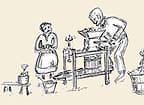|
Mendon — The Early Years
The "Peanut Line"
of the New York Central Railroad
by
John G. Sheret
January 1, 1853, proved to be an exciting day for the residents of Honeoye
Falls when the first train of the newly built Canandaigua to Batavia Railroad
arrived
in the village. Large crowds turned out for the event and everyone was offered
a free ride to Batavia and back.
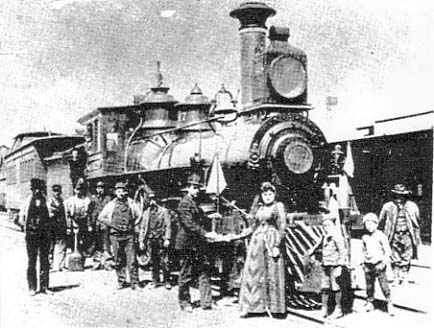
Peanut Line passenger train at the Honeoye Falls station.
Photo is dated 1853,
the year that service began
between Canandaigua and Niagara Falls.
(Courtesy
of Honeoye Falls Historian)
By July 1st of that year the railroad was extended
to Niagara Falls, and on July 28th, the first passenger train, operated as
an excursion train, ran over the completed road. Historical accounts differ
on whether
the line was acquired by the New York Central Railroad in 1855 or 1857. In
any event it became known as the "Peanut Line" after Dean Richmond, a company
vice-president, referred to the acquisition as "only a peanut of a line." The
official New York Central designation for the line was the "Batavia Branch."
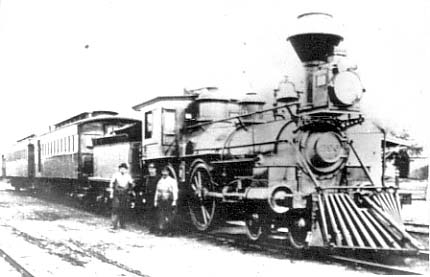
1887 photo of crew standing by engine No. 296 at the
Honeoye Falls station
of New York Central's Peanut Line.
(Courtesy of Honeoye Falls/Mendon Historical
Society)
The Peanut Line had its genesis at a meeting, held in Lima, NY, on March 4, 1851,
relative to the construction of a six-foot gauge railroad from Canandaigua to
Niagara Falls, a distance of ninety-eight and one-half miles.
(Author's Note: The gauge, the distance between the rails, was changed from
six feet to the standard four feet, eight and one-half inches shortly after
the line was acquired by the
New York Central Railroad.)
The first Board of Directors consisted of six men from New York City in addition
to Isaac Seymour of Peekskill; the noted surveyor, Augustus S. Porter of Niagara
Falls; Benjamin Pringle of Batavia; Samuel Rand of Mendon; Francis Paul of
Canandaigua; George Wright of East Bloomfield; and Ira Godfrey of Lima. The
estimated cost of construction was two million five hundred thousand dollars.
S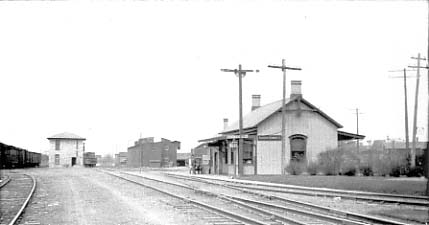
Depot at the Honeoye Falls station of the Peanut Line.
Building at left background is stone water tower.
(Courtesy of Honeoye Falls/Mendon Historical Society)
On a street in Honeoye Falls, appropriatedly named Railroad Avenue (now Norton Street), the New York Central constructed a depot for the convenience of its passengers. Located behind that building was a large warehouse for the storage of incoming and outgoing freight. Across Railroad Avenue from the depot was a large wood-frame building known as the Pan American Hotel used primarily by New York Central employees during their layover periods.
From the year of its acquisition through the first two decades of the 20th Century, the Peanut Line proved to be a prosperous branch for the New York Central Railroad. Shipments of farm products: potatoes, cabbage, beans, and fruit in addition to flour from the two stone grist mills, made up trainload after trainload shipped from Honeoye Falls.
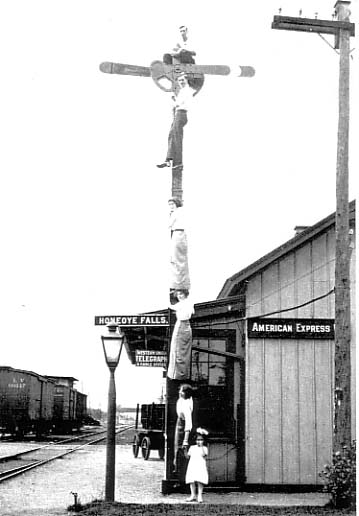
Does anyone know what this group of people is up to?
If you do, please let the author know. Length of women's
skirts indicates that the photo was taken in early 1900's.
(Courtesy of Honeoye Falls/Mendon Historical Society)Long lines of farm wagons extended along Railroad Avenue as far as the intersection
at West Main Street awaiting their turn to transfer produce of various sorts
to boxcars. The leading buyers and shippers were Humphrey & Holdridge, Downey & Lay,
Cutler & Tring, and F. P. Jobes, all owning large warehouses in the area.
The railroad, in addition to the freight operations, provided excellent passenger service with three trains a day, with the exception of Sunday, stopping at Honeoye Falls.
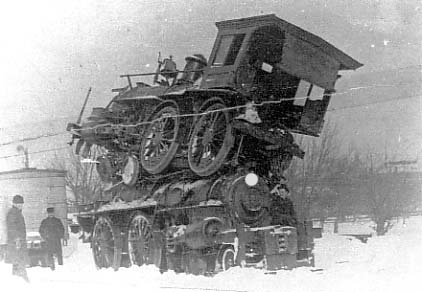
Railroad workers at Batavia station surveying damage to
the two Peanut Line
locomiotives that had collided during a
severe snow storm in February 1885.
(Author's Collection)
The February 20th, 1885, issue of the Rochester Morning Herald carried
an account of an unusual accident that had occurred two days previous on the
Peanut Line during a severe snow storm. A westbound passenger train with three
locomotives had become hopelessly stalled in deep snow east of the Batavia
station. The exact location was not known but it was believed to be about three
miles from that station. A snowplow, propelled by two locomotives, was dispatched
from Batavia and, when it was about two and one-half miles out, crashed into
the stalled train. The snowplow elevated the leading locomotive of the stalled
train on top of the locomotive equipped with the snowplow. Fortunately the
crew members of both trains, aware of the impending collision, jumped to safety
and received only minor injuries. The wrecked locomotives were taken to the
railyard at Batavia where the accompanying photo was taken.
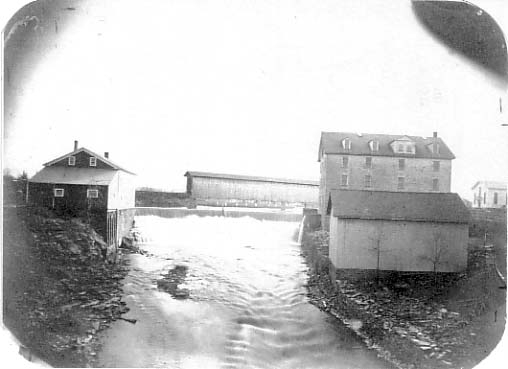
Photo is circa 1880 and reveals an excellent view of
the Peanut Line covered
bridge over Honeoye Creek.
Building on left bank of creek is the "Red" sawmill,
large stone building on the right bank is the "Upper Mill"
and small building
on far right is the Catholic Church.
(Courtesy of Honeoye Falls/Mendon Historical
Society)
The Peanut Line crossed Honeoye Creek near the Upper Mill in the village by
means of a covered bridge constructed of wood. Large hand-hewn timbers were
supported in the center of the creek by an abutment built of huge blocks of
limestone from a quarry located a short distance away on the same creek.
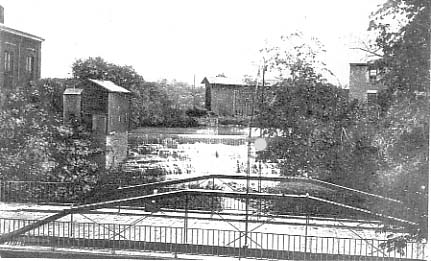
Early view of the falls on Honeoye Creek.
Covered bridge is in center background.
Building
on left edge of creek is sawmill.
(Author's Collection)
After forty years of service the bridge was replaced on July 31st, 1893,
with an iron bridge. Over two hundred feet long, the bridge was shipped from
the manufacturer in quarter sections, each occupying three flat railroad cars.
The work of assembling the sections in place was performed on a Sunday, a day
when there were not trains on the branch, thus ensuring no interruption in
service. Workers had removed the wood roof of the bridge the previous day
and discarded the material into the creek where it was salvaged by village
residents who hauled it home for firewood.
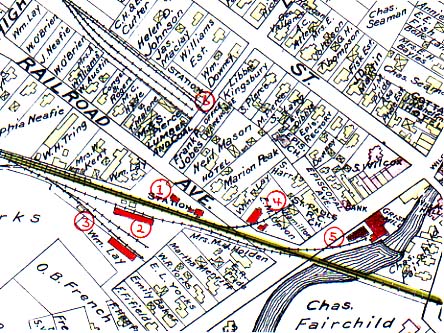
1902 Plat Map of Honeoye Falls
1. New York Central Railroad Depot
2. New York
Central Freight House
3. Spur to William Lay Produce, Coal and Grain Warehouse
4.
Spur to E. M. Upton Lumber Yard
5. Spur to Hamilton Grist Mill
6. Lehigh Valley
Railroad Depot
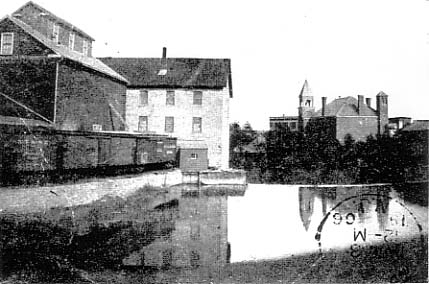
This 1906 postcard shows freight cars on a siding of the Peanut Line at
the Upper Mill.
Large frame building at left was storage for mill and was
demolished in 1963 for a
parking lot. Stone mill building is now the Mendon
Town Hall. Building in right
background is Honeoye Falls Village Hall. (Author's Collection)
During the 1930's decade, the Peanut Line met the fate of many similar small
branch lines in the New York Central System. Down to two or three passengers
per trip, this service passed out of existence in 1933. On January 5th, 1939,
it was announced that the freight service on twenty-five miles of "dead track"
between the villages of Holcomb and Caledonia would be discontinued. This decision
eliminated the stations at Ionia, West Bloomfield, Honeoye Falls, West Rush,
and Golah. In spite of the cold weather on January 15th, may old-time residents
lined the track to bid a sad farewell to the Peanut Line.
It was noted at the time that improved highways and the great increase in
the use of over-the-road trucks had reduced freight buisiness on the Peanut
Line to the point that it was no longer profitable for the New York Central
to operate the line.
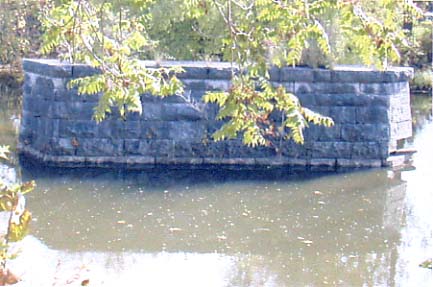
Abutment of limestone blocks that supported Peanut Line Bridge across Honeoye
Creek
can still be seen from parking lot at the Mendon town Hall. (Photo by
author)
On June 1st, 1939, the Honeoye Falls Times reported that the iron
bridge had been removed, leaving only the limestone abutment as a reminder
of an earlier
era in the transportation history of the Village of Honeoye Falls and the Town
of Mendon. The large freight warehouse was torn down several years ago and
upscale town houses are now being built on the site. The passenger depot was
moved to No. 6 Maplewood Avenue and converted into a private home and the
former Pan American Hotel is now an apartment building.
Sources of Information
Rochester Morning Herald
Rochester Democrat & Chronicle
Honeoye Falls
Times
Honeoye Falls/Mendon Historical Society
|

